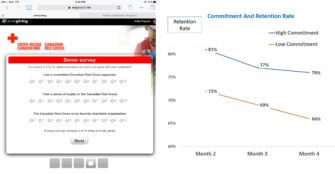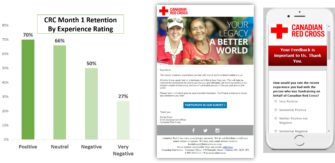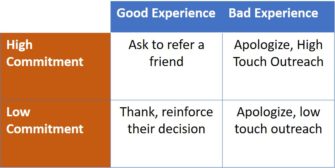The Zero Party Future is Already Here – Proof.
Canvassing is the number one method for acquiring sustainers (according to Target benchmarking). There is a lot of money being spent and a lot of donor loss occurring, especially in the first few months.
What to do about it? A lot of forward-thinking brands (e.g. TNC, ACLU, No Kid Hungry, Special Olympics) have been using zero-party (i.e. data willingly, knowingly provided by the donor) for months if not years to help address retention by gaining greater understanding of who these folks are.
EXAMPLES OF BENEFICIAL USE OF ZERO PARTY DATA
Canvassing: Canadian Red Cross
Here is a specific example from Canadian Red Cross and their exemplary leaders, Jay Hollister and Andrew George, who help make it possible. [Note: the process described can be applied in the exact same way in digital and TM]
The image on the left is from the tablet software used by the canvasser showing the Commitment measure, which is collected from every person that signs up. This is an ongoing census of newly acquired donors, not a random sampling.
The census, zero-party data collection is baked into the user experience and sign up process. Why? Because it matters to retention as the chart on the right shows — the retention rate at Month 2-4 broken out by those with High/Low Commitment to Canadian Red Cross.

Using a DonorVoice platform and process Canadian Red Cross also measures satisfaction with the canvasser interaction. They do this shortly after the interaction (and using the proper diagnostic measure for this experience) and you can see why. When the experience is bad or less than positive it leads to precipitous fall-off in retention.
It should be noted that most donors have very good experiences but when it’s bad, it’s bad…

None of this data capture and measurement is done merely for the sake of it and certainly not for the purpose of just producing charts and reports. Based on this data Canadian Red Cross purposely changes the supporter experience of the newly acquired donor in a meaningful way because of new insights unearthed from this zero-party data.
For starters, they send out tailored communications following the 2×2 matrix below. The matrix groups supporters based on each donor’s Commitment level and Satisfaction.

Canadian Red Cross also use a predictive churn model from DonorVoice process and platform that combines first party (e.g. sign-up amount, location of signup, payment method) with zero-party (e.g. age, Commitment, Satisfaction) to identify who is at-risk of quitting 90 days before it happens. The model is much more accurate when including the zero-party data. In fact, the model kind of sucks without it.
Then, using a telemarketing script that is tailored to what the organization knows about these at-risk donors they conduct a pre-emptive “save” call that cuts 3-month attrition in half.
The only way this attrition-reducing activity is possible is because of the organizational mindset and culture that assigns value to digging deeper and getting much more rigorous about relationship building. Serious, meaningful relationship building can only occur by learning more about who these folks are and the experiences they are having with the brand at a 1:1 level.
Digital and Online: Project Hope
Or take this example from the digital world and online giving. In our experience almost every single donation form/process, regardless of CRM or web platform, has huge user experience failures unknowingly built in. Walking a mile in the donor’s shoes isn’t possible by some vicarious means. You must ask the donor directly.
Project Hope did just that by embedding a short, purposeful, zero-party data capture post-online donation. You can see the diagnostic, experience measures that included close-coded, structured questions along with dynamic, open-end prompts to get specific details on what was “broken”.

This process began in mid-2015 with a lousy donor experience (orange above blue line) and equally lousy conversion rates among those on the donate form.
By collecting detailed, specific user experience ( zero-party data) data Project Hope was able to make simple, low cost changes that importantly, would never have surfaced in some internal “ideation” session designed to walk that proverbial mile in the donor’s shoes.
The result? The orange and blue experience ratings flip-flopped. The result? A significant change in conversion; making more money without reverting back to the downward spiral, of the conventional, non-solution of resorting to asking more and more often.

What’s stopping your organization from getting in the game on zero-party data?
We’ve both heard our fair share of objections to taking the time and effort to effectively capture and use zero-party data. Maybe somebody in your organization has already erected these same barriers/excuses.
If so, maybe these counterpoints to the usual “it won’t work” excuses will prove useful.
- Excuse: “People don’t reply to surveys”
- Counterpoint: more people respond to surveys than to acquisition appeals and we still send those out.
- Counterpoint: think census, not sample. If you build donor Identity and Commitment scores into your acquisition process and treat it for what it is – data as valuable as the bank details – you can have 100% coverage for all newly acquired donors (in many channels). But what about our existing supporters? You can get coverage there, over time but focus on your real pain point – year one, if only because it comes before year 2,3,4…
- Excuse: “People don’t do what they say”
- Counterpoint: They also don’t do what they did as evidenced by retention rates and 2ndgift conversion.
- Ask a lousy survey question and you get lousy answers
- Ask a well-constructed question on something donors can reliably answer, and you get insights that you simply cannot get anywhere else – period.
- Excuse: “Where do we store it?”
- Counterpoint: We struggle mightily with this question but it keeps coming up so it must be real. Storing this doesn’t require symbology or speaking in an ancient tongue. It is letters and numbers, alpha and numeric.
- Counterpoint: Stop overcomplicating everything. Standing committees at the UN spend less time deliberating on nuclear proliferation than gets spent debating how to store information in your CRM. It is letters and numbers and every CRM we know of has custom fields available.
- Excuse: “How would we use it?”
- Counterpoint: if you don’t know how to use the data you are collecting and storing on the CRM then stop doing it. This is not so much a regulatory comment (though that matters with GDPR and will matter increasingly in the US), as it is a comment on a massive time suck. Time is our most precious commodity. So, save yourself a few time-wasting meetings if the question of data storage doesn’t start with “how you plan to use it?” More specific to this, if you don’t know how you’d use data that segments your supporters based on their motivation (Identity) and loyalty (commitment) to your brand and report just having had a good/bad experience at your gala/walk/run/online donation process then maybe it’s time to consider another line of work.
Yeah, we know this sounds pretty flippant or snarky. But the question of “how do we use data” is truly perplexing to us. But then if it seems so obvious, we are probably too close to the issue.
So, if you have genuine questions about how to use this kind of zero-party data for your specific organization by all means let us know and we’ll provide a non-flippant response.
Roger and Kevin


